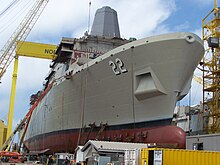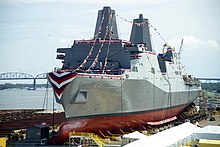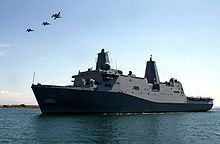San Antonio class
 USS San Antonio in 2006 off New York |
|
| Overview | |
|---|---|
| Type | Amphibious Transport Dock |
| units | up to 12 planned, 11 in service, 1 under construction |
| Namesake | City of San Antonio , Texas |
| period of service |
since 2005 |
| Technical specifications | |
| displacement |
fully loaded 24,900 ts |
| length |
208.05 meters |
| width |
31.9 meters |
| Draft |
7.0 meters |
| crew |
28 officers, 332 men, up to 800 Marines |
| drive |
Four diesels on 2 propellers, 41,000 shaft horsepower |
| speed |
22+ knots |
| Armament |
2 guns 30 mm, 2 launchers for anti-aircraft missiles |
The San Antonio- class is a class of amphibious transport docks of the United States Navy . The ships are used for amphibious warfare . Originally, the Navy was to receive twelve ships from 2003 to transport US Marines and their material. After problems with construction and the associated delays and cost increases, only eleven ships have been approved so far, the first of which has been operational since 2008.
The ships have been planned according to the principles of stealth technology , and the comfort for the crew and the marines is to be increased compared to the previous fleet.
history
Planning and construction
In the early 1990s, the Navy began planning a new class of amphibious transport docks. At the end of 1996, a consortium led by Avondale Shipyard won the tender for the new class, mainly because the entire planning was to be computer-aided. Accordingly, Avondale should build eight of the planned twelve ships and four should be built by Bath Iron Works . The competitor for the contract was Ingalls Shipbuilding . In 1997, the Navy began researching new crew reduction technologies on the USS Rushmore (LSD-47) as part of the Gator 17 program .
However, after the initial construction contract was awarded in 1998, Avondale discovered that the computer systems were difficult to use and inefficient. After making small changes, large parts of the computer data had to be adapted. Such changes came on the part of the Navy after budget cuts until after construction began, which caused the shipyard great difficulties in connection with the computer problems. In 1999 Avondale was taken over by Litton Industries , the mother of Ingalls. 2001 Litton was again taken over by Northrop Grumman , who took over the management of the project. In 2002, the Navy agreed with Northrop Grumman and General Dynamics , the owner of Bath Iron Works, to swap the four ships to be built near Bath for four Arleigh Burke- class destroyers to be built at Ingalls. Thus, all orders were in the hands of Northrop, which the Navy hoped for a faster processing of the program.
However, the problems persisted. In 2000 the first ship was laid down. After more than three years of construction, the LPD-17 was launched at the end of 2003. The final equipment did not go as planned either, the Navy accepted the ship in 2005 despite numerous defects. According to the Naval Sea Systems Command and the Board of Inspection and Survey , there were major problems with corrosion, electrical wiring and occupational safety on the ship. The report called the work of the shipyard "poor craftmanship", ie poorly crafted. There were also doubts about the water tightness and thus the seaworthiness of the ships.
Only days after the ship was taken over by the Navy, Hurricane Katrina struck the Gulf Coast, where the two shipyards are located, and devastated them, which further delayed the entire project. LPD-17 was put into service in early 2006 after an initial overhaul at Ingalls, but was still not operational. The Navy had a repair carried out at its own expense, the ship first relocated in August 2008, around five years behind the original schedule. The second unit of the class was also incomplete in 2006 and relocated for the first time in 2009. Only the third unit of the class, which was built at Ingalls instead of Avondale, was taken over by the Navy at the end of 2007 and ready for use.
So far, eleven of the originally planned twelve ships of the class have been approved, it is unclear whether funds will also be provided for the last one. Two more of the nine ships are built by Ingalls, the rest by Avondale. The delays have also caused the price of ships to skyrocket. At the end of the 1990s, the Navy assumed around 750 million US dollars per unit, but the actual costs are currently 1.3 to 1.8 billion dollars per ship.
Plans for 2017 envisage the construction of a modified LX (R) class of 13 ships as the successor to the LSD ships of the Harpers Ferry class and the Whidbey Island class . The equipment is reduced on these ships. The Advanced Enclosed Mast / Sensor will be replaced by conventional masts, the flight deck will be made smaller and the aft deckhouse will be modified. The capacity for marines will be reduced to 500 men and the on-board hospital area will be halved. The start of construction is planned for 2022 after the completion of the last ship of the San Antonio class.
designation
The units were to be named after cities in the United States, as was the tradition for older Amphibious Transport Docks. The lead ship, and the class derived from it, was named after San Antonio , the first ship in the Navy to bear the name of the Texan metropolis.
On November 19, 2004, the USS Mesa Verde (LPD-19) was named when it was launched for Mesa Verde , a table mountain, settlement area of the Anasazi and the most historically significant national park in the USA (UNESCO World Heritage Site).
After the terrorist attacks on September 11, 2001 , Secretary of the Navy Gordon R. England made another exception and named LPD-21 after New York State . The USS New York carries 7.5 tons of steel debris from the World Trade Center in its forward stem . Also in honor of the victims of September 11th, two more units were named after Arlington County (LPD-24) and Somerset County (LPD-25). The Pentagon , which was attacked on the same day , is in Arlington , and United Airlines Flight 93 crashed in Somerset .
The tenth ship of the class, LPD-26, is named after John P. Murtha , deviating from the naming scheme of the class . Murtha served in the Marine Corps in the Korean and Vietnam War and during his time as a member of the House of Representatives he campaigned for the expansion of the amphibious fleet.
period of service
The planned twelve ships of the San Antonio class are to replace 41 ships for amphibious warfare of older designs. These belong to the Austin , Newport , Charleston and Anchorage classes .
The delays in the construction of the class also have an impact on the service time of these older classes, which has to be extended in some cases so that the Navy can maintain its transport capacity. This applies above all to the Austin class, whose ships were built over 40 years ago. Additional costs are incurred here due to the extension of the service period. In addition, the modernization of the fleet is being delayed because the operational introduction of new weapon systems or the tilt rotor aircraft Bell-Boeing MV-22 has to be postponed. The conditions for crew and troops, to which special emphasis was placed on the San Antonios , thus lag behind the current ideas of the Navy.
Capacity issues can also arise as the last two Newport- class ships were sold in the early 21st century, the five Charleston- class ships were mothballed before 1995, and the five Anchorage- class ships were decommissioned in 2003.
The San Antonio- class units will remain in service until the mid-21st century.
technology
hull
The hull of the San Antonio class ships is around 208.5 meters long and 31.9 meters wide. The draft is 7 meters. When fully loaded, the ships displace around 25,000 ts . Steel was used as the material for the hull, the superstructures are also made entirely of steel, composite materials were only used for the masts . Around the front half of the deck is occupied by deckhouses and a hangar for helicopters, behind which there is a landing deck for helicopters across the entire width.
The fuselage was planned and built according to the principles of stealth technology . Experience with the test ship Sea Shadow (IX-529) and the Arleigh Burke class was used. Outwardly, this can mainly be seen in the chin kink: the lower part of the torso is inclined outwards, above it it is inclined inwards. This minimizes the broadside echo and thus the radar cross section . Dispensing with conventional pole or lattice masts in favor of the Advanced Enclosed Mast / Sensor (AEM / S) also helps reduce the cross-section. However, several cuts and problems encountered during construction increase the radar cross-section for the first unit again. Numerous “hot spots” were inadequately provided with suitable, radar-repellent protective covers, pipelines are made round instead of square and the like. The Board of Inspection and Survey also sees a need for improvement here.
Embarkable land, water and air vehicles
A large part of the deck is occupied by a landing deck and the associated hangar, below deck there is a corrugated deck and additional storage space.
Helicopters are not permanently stationed on the units; San Antonio aircraft can only be temporarily assigned to a San Antonio during operations . However, each unit has personnel for handling aircraft in the hangar, for example. Aircraft can be serviced or refueled here. This hangar can accommodate two Boeing-Vertol CH-46 Sea Knight or three Bell AH-1 Sea Cobra or one Sikorsky CH-53 Sea Stallion or one Bell-Boeing MV-22 Osprey . Double the capacity is available on the landing deck, where a Boeing AV-8B Harrier II can land and take off.
Inside the ships there is a floodable corrugated deck that can be entered from the aft through a large gate. There is space for two Landing Craft Air Cushioned or one Landing Craft, Utility . Alternatively, up to twelve AAV7s can be placed in the well deck. Originally, twelve Expeditionary Fighting Vehicles were also planned. The development of this armored amphibious assault vehicle intended as the successor to the AAV7 was discontinued. Towards the bow there are three decks for loading a mission-specific mix of vehicles and cargo. These offer around 2300 m² of space, e.g. B. for 14 more AAV7. In addition, 700 m³ of cargo space for ammunition and 1200 m³ for fuel are available for the embarked vehicles.
drive
The units are of four turbocharged marine diesels by Fairbanks-Morse driven, which were produced under the brand name Colt Pielstick. These drive two shafts with one propeller each via two reduction gears. Be used Bird Johnson - pitch propellers of Rolls-Royce Naval Marine . The system has an output of 41,600 shaft horsepower and a speed of over 22 knots.
The electrical energy is supplied by five diesel-powered generators manufactured by Caterpillar , each with an output of 2500 kilowatts.
Armament and Electronics
A Bushmaster II ship gun is installed at the bow and aft , a version of the M242 Bushmaster enlarged to a caliber of 30 millimeters . This can be used against smaller surface targets as well as a close-range defense system. To ward off approaching missiles, there is a starter for 21 RIM-116 Rolling Airframe Missiles at the bow and aft .
At the beginning it was planned to install a Vertical Launching System (VLS) to accommodate the RIM-162 Evolved Sea Sparrow Missile (ESSM), which should give the ships a certain offensive capacity. After delays also occurred in the ESSM program, the VLS was not installed on the first ships. However, the space and the necessary additional weight are reserved so that retrofitting is possible. It is still unclear whether this will happen on later units.
All radar devices are hidden behind the radomes of the two AEM / S for camouflage reasons and therefore cannot be seen. As the surface search radar which is PLC 73 by Raytheon used. A SPS-48 from ITT-Gilfillan is on board as a 3D aerial search radar . The guns are one of SPQ-9 from Norden Systems controlled.
For electronic warfare system is SLQ-32 on board, to ward off torpedoes, a SLQ-25 Nixie be dragged. Incoming missiles are misled by the Mark 36 SRBOC or the Mark 53 Nulka .
crew
The crew of every ship of the San Antonio class consists of around 360 men. The usual strength is 28 officers and 332 men. In addition, there are 699 Marines (66 officers + 633 NCOs and soldiers) including their material with normal occupancy. For emergencies, however, up to 800 marines can be relocated to each ship.
When planning the ships, comfort for crew and troops was an important aspect. The bunks, roughly coffin-shaped on older ships, were cut out at the head area to allow seating. This is accompanied by an increase in personal storage space by 40% and a pull-out board as a writing surface. A reduction in the number of people per room is also in line with the Navy and Marine Corps' policy of bringing more women to sea, as this ensures greater flexibility.
Each ship has two operating theaters and two dental clinics, the ship hospital can accommodate 24 injured or sick people and has an intensive care unit . In addition to the ship's shop, the central “mall” also has a hairdresser and a fitness room.
Mission profile
The San Antonio- class Amphibious Transport Docks are used as part of Expeditionary Strike Groups . These are grouped around an amphibious assault ship of either the America or Wasp class , three destroyers or cruisers and a nuclear submarine are also used as escorts . The Amphibious Transport Docks serve as cargo ships in these groups.
Web links
- Fact sheet of the US Navy (English)
- San Antonio class on globalsecurity.org (English)
- San Antonio class on naval-technology.com (English)
- Report about the LX-R variant
Footnotes
- ↑ Navy Times: Bath Iron works to build last Arleigh Burke destroyer ( page no longer available , search in web archives ) Info: The link was automatically marked as defective. Please check the link according to the instructions and then remove this notice. (engl.)
- ↑ a b Report of the Board of Inspection and Survey of the US Navy on the acceptance of LPD-17 ( Memento of the original from May 21, 2008 in the Internet Archive ) Info: The archive link was automatically inserted and not yet checked. Please check the original and archive link according to the instructions and then remove this notice. (engl.)
- ↑ Navy Times: SecNav rips shipbuilders over LPD 17 ( page no longer available , search in web archives ) Info: The link was automatically marked as defective. Please check the link according to the instructions and then remove this notice. (engl.)
- ↑ Navy Times: InSurv: LPD 18's fighting ability 'degraded' ( page no longer available , search in web archives ) Info: The link was automatically marked as defective. Please check the link according to the instructions and then remove this notice. (engl.)
- ↑ Navy Times: Troubled amphib program appears on track ( page no longer available , search in web archives ) Info: The link was automatically marked as defective. Please check the link according to the instructions and then remove this notice. (engl.)
- ^ Stefan Terzibaschitsch : Seemacht USA , Bechtermünz-Verlag, ISBN 3-86047-576-2 , page 890




